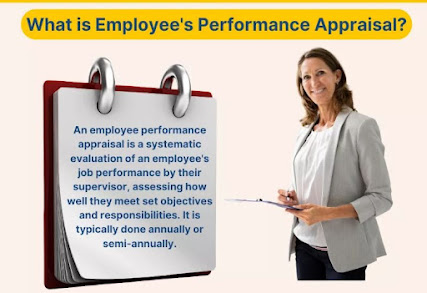Performance Appraisal
Introduction
Appraisals are evaluations of an employee's performance and their
contribution to organizational goals. The employee's manager or supervisor
usually conducts the appraisal. They typically take place on a yearly basis and
may also be called an annual review.
The process is systematic and assesses the employee against a
number of fixed criteria. Factors that the appraisal considers
include. (Indeed Editorial Team, n.d.)
- Attitude
- Work ethic
- Attendance
- Competence
What is Performance
appraisal?
Performance appraisal refers to Regular review of an employee's
job performance and overall contribution to a company. Also known as an annual
review, employee appraisal, performance review, or evaluation, a performance
appraisal evaluates an employee's skills, achievements, and growth.
Types of Performance Appraisals
1. Key Components of Performance Appraisal:
Performance appraisals
generally involve setting performance standards, measuring actual performance,
comparing the two, and providing feedback.
2. Benefits of Performance Appraisal:
Performance appraisals
can improved employee performance, increased job satisfaction, and better
alignment between individual and organizational goals. They also provide a
platform for recognizing and rewarding high performers, which can boost morale
and motivation
3. Challenges of Performance Appraisal:
Common challenges
include biases in evaluation, lack of clear criteria, and the potential for
demotivation if feedback is not delivered constructively. Additionally,
traditional annual reviews may not provide timely feedback, which is essential
for continuous improvement.
4. Strategies for Improving Performance Appraisal:
To address these challenges, organizations can adopt more
frequent and development-focused feedback sessions, use multiple raters to
reduce bias, and ensure that appraisal criteria are clear and objective
In conclusion, performance appraisal is a vital process for
organizational success, but it requires careful implementation to be effective.
By addressing common challenges and adopting best practices, organizations can
enhance the value of performance appraisals, leading to improved employee
performance and satisfaction. As the workplace continues to evolve, it is
essential to adapt performance appraisal systems to meet the changing needs of
both employees and organizations.
Reflection
Reflecting on the impact of performance appraisal highlights its
potential to drive employee development and organizational growth. While
traditional appraisal methods have faced criticism, innovative approaches such
as strengths-based appraisals and continuous feedback can significantly improve
the process. By focusing on development and recognizing employee strengths,
organizations can create a more positive and motivating appraisal experience.
As we move forward, it is crucial to continue exploring and refining
performance appraisal practices to ensure they meet the needs of a dynamic and
diverse workforce.
References
- Cespedes, F. V. (2022). How to Conduct a Great Performance Review. Harvard Business Review. Retrieved from https://hbr.org/2022/07/how-to-conduct-a-great-performance-review
- Cappelli, P., & Tavis, A. (2016). The Future of Performance Reviews. Harvard Business Review. Retrieved from https://hbr.org/2016/10/the-performance-management-revolution
- Van Woerkom, M., & Kroon, B. (2020). The Effect of Strengths-Based Performance Appraisal on Perceived Supervisor Support and the Motivation to Improve Performance. Frontiers in Psychology. Retrieved from https://www.frontiersin.org/journals/psychology/articles/10.3389/fpsyg.2020.01883/full

.webp)
.png)

For HR teams, performance appraisals offer valuable insights into workforce needs, training requirements, and overall productivity levels. When done effectively, appraisals can boost employee motivation, clarify expectations, and strengthen the employer-employee relationship. The idea had been clearly explained through the blog post & well done!
ReplyDelete